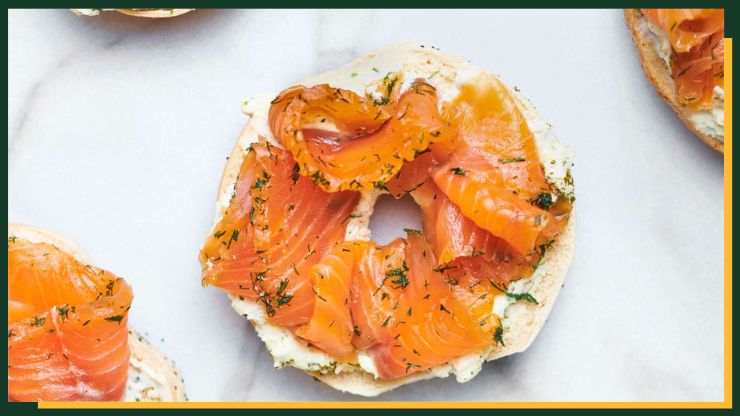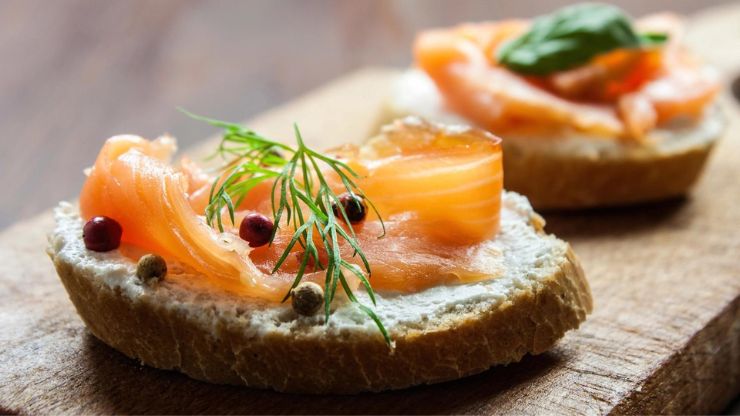How to Make Lox – Lox, a renowned dish with profound cultural roots, takes the basic salmon and turns it into a fine dining experience. Originating from traditional Jewish cuisine, lox has become a staple in many culinary traditions worldwide.
This preparation involves curing fresh salmon with a blend of salt, sugar, and aromatic ingredients like dill and lemon zest. The process, though straightforward, requires precision and patience. As the salmon undergoes its transformative cure, it absorbs flavors, resulting in a delectably rich and slightly salty profile.
Whether enjoyed on a bagel with cream cheese or as an elegant appetizer, homemade lox promises a culinary adventure. In this guide, we’ll explore the step-by-step process of crafting this delectable treat, allowing you to savor the satisfaction of creating your own flavorful, artisanal lox at home.
Table of Contents
ToggleBasic distinction between lox and smoked salmon
The fundamental difference between smoked salmon and lox is how they are prepared. Salmon that has been cured in a brine of sugar and salt, and frequently infused with flavors like lemon zest and dill, is called lox. The curing process imparts a silky texture and a mildly salty taste to the fish. Lox is typically not smoked, and its preparation relies on the curing process alone.
On the other hand, smoked salmon undergoes both curing and smoking. After the initial curing stage, the salmon is then cold-smoked or hot-smoked to add a smoky flavor to the fish. This additional smoking step imparts a more robust and pronounced smokiness to the salmon, giving it a distinct flavor profile compared to the milder taste of lox. While lox is characterized by its silky texture and subtle saltiness, smoked salmon has a firmer texture and a more intense, smoky flavor.
Also, Read – How to Make Harissa Chili Sauce
How to Make Lox

Lox is a popular dish made from brined salmon fillet, typically served on bagels with cream cheese, capers, and onions. Here’s a basic recipe for making lox at home:
Ingredients:
- 1 pound (about 450g) of fresh salmon fillet, preferably wild-caught
- 1/2 cup kosher salt
- 1/2 cup granulated sugar
- 1 tablespoon coarsely ground black pepper
- Zest of one lemon (optional)
Prepare the Salmon
Rinse and pat dry 1 pound of boneless salmon fillet. Mix 1/2 cup kosher salt, 1/2 cup sugar, 1 tbsp black pepper, and optional lemon zest. Lay the salmon on plastic wrap with half of the mixture spread over it, then top with the remaining mixture.
Wrap tightly, refrigerate in a dish for 24-48 hours, turning every 12 hours. Unwrap, rinse off excess salt, and slice thinly at an angle. Serve on bagels with cream cheese, capers, and onions. Store leftovers in the refrigerator for up to a week or freeze for longer storage.
Prepare the Brine
Combine 1/2 cup kosher salt, 1/2 cup granulated sugar, 1 tbsp coarsely ground black pepper, and optional lemon zest. This mixture forms the brine for your salmon. Lay a large piece of plastic wrap or aluminum foil on a flat surface, spread half of the brine on it, and place the salmon, skin side down. Cover the salmon with the remaining brine and wrap it tightly.
Ensure even coating. Place the wrapped salmon in a dish in the refrigerator for 24-48 hours, turning every 12 hours. After brining, rinse the salmon under cold water to remove excess salt before slicing.
Coat the Salmon
Dry off one pound of newly purchased boneless fish fillet. Combine one tablespoon of finely powdered black pepper, half a cup kosher salt, half a cup granulated sugar, and optional lemon zest in a bowl. Lay a large piece of plastic wrap or aluminum foil on a flat surface and spread half of the brine mixture on it.
Place the salmon, skin side down, on the brine. Cover the salmon with the remaining brine, ensuring even coating. Wrap the salmon tightly with the plastic wrap or aluminum foil. Place the wrapped salmon in a shallow dish in the refrigerator for 24-48 hours, turning every 12 hours for consistent brining.
Don't just scroll, subscribe!
BuzzTrail's unique web-stories are the cure for boredom you've been waiting for.
Also, Read – Probiotic Fig Butter
Wrap and Refrigerate
Tightly wrap the brined salmon with plastic wrap or aluminum foil, ensuring it’s well-sealed. The salmon should be wrapped and placed in a shallow dish to collect any possible liquids. This dish contributes to the cleanliness of the refrigerator. Refrigerate the wrapped salmon for 24-48 hours, allowing it to absorb the flavors of the brine.
Turning the salmon every 12 hours ensures an even infusion of flavors. The extended refrigeration time contributes to the development of the desired texture and taste in the salmon. After the brining period, unwrap the salmon and proceed to rinse off any excess salt before slicing for serving.
Brine the Salmon
Place the wrapped salmon in the refrigerator to allow it to marinade for at least 24 to 48 hours. This period allows the salt, sugar, and pepper mixture to infuse the salmon with flavor. Turning the salmon every 12 hours ensures an even distribution of the brine. The extended brining time contributes to the development of the desired texture and taste in the salmon.
This transformative process enhances the overall quality of the dish. After the brining period, carefully unwrap the salmon and rinse it under cold water, removing any excess brine. The result is a perfectly brined salmon ready for slicing and serving.
Remove and Rinse
After 24-48 hours of brining, carefully unwrap the salmon. Rinse the salmon under cold water, removing any excess salt. In order to attain the appropriate flavor balance, this step is essential. Gently pat the salmon dry with paper towels. The rinsing process helps eliminate excess salt while preserving the infused flavors.
Now that the salmon is prepared, slicing it will expose a nicely textured and seasoned interior. This meticulous approach ensures a harmonious blend of sweet, savory, and peppery notes in every slice. Proceed to cut thin, angled slices for serving on bagels or with other preferred accompaniments.
Slice and Serve
With a sharp knife, thinly slice the brined salmon at a slight angle. This technique ensures delicate, flavorful slices ideal for lox. For a traditional presentation, serve the sliced salmon on bagels with cream cheese, capers, and red onions.
The result is a delectable combination of rich, savory salmon with the creaminess of the cheese and the vibrant, tangy notes of capers and onions. Enjoy the homemade lox creation as a delicious addition to brunch or as a versatile culinary delight. Store any remaining slices in the refrigerator for up to a week, or freeze for longer-term storage.
Storage
Store any leftover lox in the refrigerator for up to a week. Ensure proper sealing to maintain freshness. Alternatively, for longer storage, consider freezing the slices. Wrap individual portions tightly in plastic wrap and place them in an airtight container or a resealable freezer bag.
Label the container with the date for reference. Frozen lox can be stored for several months. When ready to use, thaw the slices in the refrigerator before serving. This allows for a convenient and versatile way to enjoy homemade lox over an extended period while preserving its quality and flavor.
Conclusion
In conclusion, mastering the art of crafting lox offers a culinary journey that transforms simple salmon into a delicacy rich in tradition and flavor. With patience and attention to detail, the curing process creates a silky texture and mild saltiness, distinguishing lox from its smoked salmon counterpart.
Whether enjoyed on a bagel or as an elegant appetizer, the satisfaction of creating homemade lox resonates in each delectable bite, inviting you to savor the nuances of this timeless dish while appreciating the culinary prowess that comes with making it yourself.
FAQs
How long does it take to cure lox?
How long does it take to cure lox?
The curing time for lox typically ranges from 24 to 48 hours in the refrigerator. The longer it cures, the firmer the texture will be.
Can I make lox without a smoker?
Can I make lox without a smoker?
Yes, lox is traditionally not smoked. The curing process alone gives it its distinctive flavor and texture. However, some variations may include a cold smoking step for added flavor.
What are common accompaniments for serving lox?
What are common accompaniments for serving lox?
Lox is often served on bagels with cream cheese, red onion, capers, and fresh dill. It also pairs well with thinly sliced tomatoes or cucumbers.

